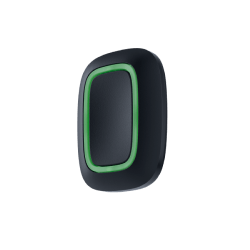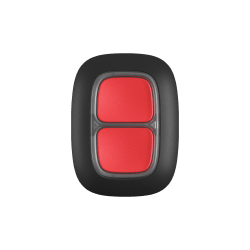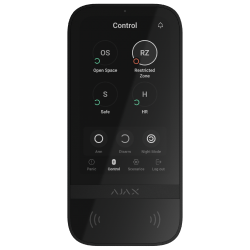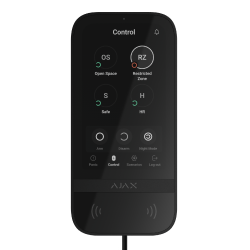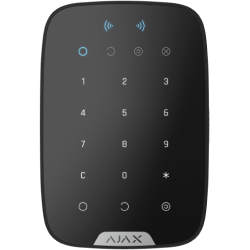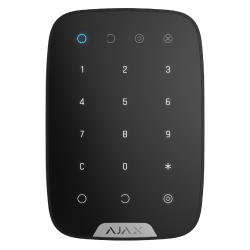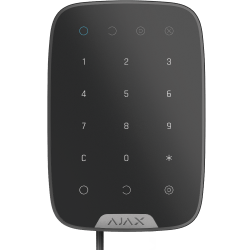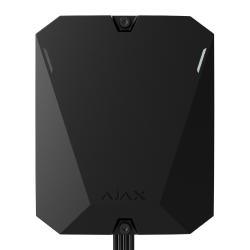In life-threatening situations, there is no room for delays. When a burglar breaks into a store, the cashier may find themselves trapped: any wrong move can provoke the intruder, and calling for help seems impossible. However, a tiny security panic button concealed in the cash register can send a silent alarm to the security personnel and turn the situation around.
Panic buttons are a convenient and straightforward way to signal an alarm. They can be installed on any flat surface, carried around on a key ring, or even worn on a wrist or around the neck. This makes them an excellent choice for environments where security must be within easy reach, such as hospitals, shops, banks, and many other places.
What types of panic buttons are available on the market? Who can benefit from using these devices? And what makes Ajax solutions special? Read on to find out.
Panic buttons: general overview
What is a panic button?
A panic button is a device or a feature within other devices designed to signal an emergency. It can send an alarm to a central monitoring station (CMS), security personnel, or the police. Panic buttons can also send alarms to users and trigger other devices in the system, such as sirens.
What makes panic buttons stand out among other security solutions?
- Convenience: Panic buttons come in all shapes and sizes and offer different mounting options. This makes them portable, barely noticeable, and installable virtually anywhere.
- Instant alarms: Security personnel, CMS, or the police, as well as system users, receive alarm notifications immediately after the panic button is pressed.
- Informative notifications: Security companies know exactly1 what happened, which button was pressed, and where the user in question is located.
- Silent alarm signals: Panic buttons can be set to silently notify security personnel, CMS, or the police of danger, which may be important in case of an intrusion.
Panic button use cases
Panic buttons are suitable for almost any setting where people might feel unsafe or at risk of injury. These devices are equally helpful in schools, retail stores, government buildings, entertainment venues, hotels, and even vehicles.
A panic button is a must-have security device in environments where people work or stay alone. In such situations, they are more susceptible to attacks or at a higher risk in case of a sudden health emergency. In the financial and commercial sectors, employees often deal with valuables and thus run the risk of assault and intimidation. Panic buttons also enhance the safety of guards, housekeepers, taxi drivers, and other lone workers, as these jobs are more exposed to violence. Additionally, the devices play a crucial role in the healthcare and elderly care industry, where people might need lifesaving assistance.
Beyond specific industries, panic buttons contribute to home safety by helping common residents promptly signal a dangerous situation. With a simple press of a button, they can call for help if they notice signs of a fire, smell gas, or hear someone breaking in.
Types of panic buttons
Portable panic buttons
The pocket-sized design makes portable panic buttons a perfect security solution for individuals who are constantly on the move. Depending on the model, these personal panic buttons can send1 a text message with a precise location through a hub or directly to the monitoring company. Such buttons can be carried as a key fob or worn as a wrist or neck accessory. Some portable panic buttons feature a microphone for voice communication, enabling users to describe their situation first-hand.
Fixed panic buttons
Fixed panic buttons are stationary devices that are installed in a single location and cannot be carried around. One can hardly find a public facility with no classic red fire alarm buttons. Intrusion alarm buttons can be hidden in several ways, which is especially useful for such people as store employees. These devices can be fixed under a table, inside a cash register, or even designed as a foot-operated pedal to send a silent alarm without drawing attention. Also, drivers can place panic buttons inside their vehicles to quickly notify of life-threatening situations.
Integrated panic buttons
Panic buttons can also be part of other control devices, such as keypads or key fobs. Or they can be integrated into software, which allows users to raise an alarm using a mobile app. This integration extends beyond security systems. For instance, mobile panic buttons are typically integrated into smartphone operating systems as well as taxi or car-sharing apps. Some apps are specifically designed to signal dangerous situations and allow users to call for help with a simple tap.
Ajax panic buttons: combining security and comfort
Ajax buttons for every need
Ajax panic buttons come in different formats but serve a single purpose — to make people’s lives safer. Regardless of the type, the buttons can send alarm notifications about all sorts of threats. Some buttons can also initiate specific scenarios. For instance, a fire alarm raised with the button may trigger the system to de-energize the facility to minimize fire spread.
Standalone panic buttons
Ajax panic buttons as standalone devices combine seamless functionality with thoughtful design. Their solid enclosures are suitable for mounting on flat surfaces and are built to withstand harsh environments. All panic button models feature protection from accidental pressing, which minimizes the risk of false alarms.
- Button Jeweller is a compact wireless panic button that can be fixed in Holder for surface mounting. It can also be carried as a key fob or worn on a wrist or around the neck. The button can send an alarm, control automation devices, or hush fire alarms. Superior Button Jeweller (soon to be: ), offers the same functionality while also complying with a wider range of both international and local standards, including EN 50131 (Grade 2), INCERT, SSF, UL, and ANSI/SIA CP-01.
- DoubleButton Jeweller is similar to Button Jeweller but features additional protection from accidental activation. The device has a plastic divider between two buttons, and alarms are only triggered when both are pressed simultaneously. Unlike Button Jeweller, DoubleButton can be used exclusively for sending alarms. The device is certified according to EN 50131 (Grade 2), PD 6662:2017, UL, and ANSI/SIA CP-01 standards.
- ManualCallPoint Jeweller is a wall-mounted button designed for dealing with fire alarms. It activates fire detectors’ sirens or launches automation scenarios, such as turning on emergency lights, unlocking electric locks, or de-energizing the facility. The button is protected from accidental pressing with a transparent front lid. ManualCallPoint Jeweller is available in five colors. It also complies with the EN 54-11:2001 standard.
Integrated panic buttons
In an Ajax system, panic buttons are also available as a feature of several devices.
Ajax SpaceControl Jeweller is a key fob designed for controlling security system modes. The device allows users to quickly arm, disarm, or switch the system to Night mode. Additionally, the key fob features a panic button that can send an alarm to system users and the CMS, as well as activate sirens and automation scenarios. The device is protected from accidental pressing: it can be set to respond only to a long or double press. is an enhanced model of the Ajax key fob. It is suitable for high-grade security projects that demand extended compliance with standards.
A panic button is also a feature in all Ajax keypads. KeyPad Jeweller, , KeyPad Plus Jeweller, , and Superior KeyPad Outdoor Fibra have a Function button that can be set to Panic mode. Pressing this button sends an alarm to all system users and the CMS while activating sirens in the system and running automation scenarios. KeyPad TouchScreen Jeweller and Superior KeyPad TouchScreen Fibra feature a more flexible Panic tab with three buttons: Panic button, Fire, and Auxiliary alert. These devices also have a separate tab for controlling up to six scenarios.
Panic button in Ajax apps
A panic button is integrated into the Ajax Security System app for end users and helps signal a threat using a smartphone when no other means are at hand. When the button is pressed, the app sends a notification to all users in the system and the CMS, with the exact location of the user who pressed the panic button. Users can also copy the coordinates from the events feed and share them as needed.
The Ajax mobile panic button also offers revenue opportunities for security companies. They can provide personal protection services to those who use the Ajax app but do not have a security system. Not only does this provide users with a greater sense of security but also gives companies yet another way to generate income with Ajax.
Third-party panic button integration
Replacing outdated yet usable wired buttons might be a real struggle. To save their own time and the client’s money, an installer can integrate third-party buttons into an Ajax system.
Ajax integration modules transform nearly any wired button into a full-fledged component of an Ajax security system. This allows end users and PROs to manage the button via Ajax apps. The modules can be set to transmit events and specific alarm types from third-party panic buttons and even be used to run automation scenarios.
Transmitter Jeweller is a wireless module to integrate one third-party device into an Ajax system. Wired panic buttons can be connected to the module using a cable up to 9.8 ft long.
Superior Transmitter Fibra is a wired integration module available to accredited Ajax Systems partners. Unlike Jeweller devices, it uses the proprietary Fibra wired technology to communicate with a hub. The module is really small, so it can be installed inside a button.
MultiTransmitter Jeweller is a solution that can integrate up to 18 wired devices into an Ajax system. Panic buttons can be connected using a cable up to 1.300 ft long. The wired version, Superior MultiTransmitter Fibra, is available to accredited Ajax Systems partners only.
Superior MultiTransmitter IO (4X4) Fibra features four inputs for receiving alarms from third-party devices and four outputs for controlling electrical devices and appliances. Like other Ajax wired integration modules, it transmits alarms from connected wired panic buttons via the secure Fibra protocol. Thanks to the module’s combined functionality, the integrated buttons can turn on sirens or strobe lights connected to the same module.

How do Ajax panic buttons work?
Ajax panic buttons are a part of the Ajax ecosystem and require an Ajax hub installed at the secured site. When pressed, the panic button sends an alarm to the hub. Upon receiving the alarm, the hub transmits a notification to all security system users and sends an event code to the monitoring company.
There are several ways panic buttons can enhance on-site security. In case of an alarm, they can be used to activate sirens at the facility to deter intruders or signal a threat to people nearby. Also, buttons can be configured to send a silent alarm to the monitoring company. In this case, they do not trigger sirens, and intruders do not realize the rapid response team is on its way.
Panic buttons can also activate other devices in the security system thanks to automation scenarios. They run in response to an alarm raised with the button and activate smart relays, outlets, light switches, and other automation devices. For instance, if a button signals a fire, it can trigger a WallSwitch Jeweller relay to de-energize the facility.
Ajax panic buttons support various types of alarms, including intrusion, fire, gas, and auxiliary alarms. PRO users can also set a custom alarm to signal a specific threat. In this case, only the system users receive the alarm notification, and no event code is sent to the monitoring company.

Alternatively, some Ajax panic buttons, such as Button Jeweller or Superior Button Jeweller, can function as automation controls. In control mode, these buttons allow users to manage on-site heating, all or some lights, and specific appliances thanks to automation scenarios.
Why choose Ajax
Ajax panic buttons stand out as reliable and versatile solutions that meet even the strictest international and local standards. At the very core of these devices are proprietary technologies that guarantee secure and trouble-free operation over long distances. Wireless devices use the Jeweller communication protocol, while wired devices communicate with a hub via the Fibra technology. Both protocols provide robust data encryption, protection against sabotage, spoofing, and data theft, as well as an outstanding communication range of up to 6,550 feet.
The installation of Ajax devices is significantly faster than that of competing solutions. To add a panic button to the system, the installer only needs to scan a QR code or run line scanning. The entire configuration and maintenance process is managed through intuitive Ajax apps. Combined with excellent autonomy of devices and a remote control option, this ensures low-effort and cost-effective system maintenance.
The thoughtfully designed hardware opens up various use cases for the buttons. They can be installed virtually anywhere in a facility to enhance security or run automation scenarios. All Ajax panic buttons feature protection from accidental pressing, which addresses a common issue of false patrol dispatches.
Wrapping up
Ajax offers a wide range of panic buttons in various shapes and sizes, along with modules for integrating third-party devices. These solutions are tailored to meet the needs of different projects and enhance security across various facilities. Thanks to automation devices and scenarios, these buttons have evolved into not only reliable alarm-delivering devices but also handy smart system controls.
Panic buttons provide significant benefits for both end users and monitoring companies. The latter can expand their services and drive business growth. Ajax buttons also enhance company performance, as they deliver informative notifications that enable swift and efficient responses to threats while requiring minimal on-site maintenance. For users, these buttons give confidence that in any emergency, help is within easy reach.
Products
Panic button features depend on the device type, settings, and the system in which it operates.
Roman Konchakivskiy
Head of Ajax Academy
















